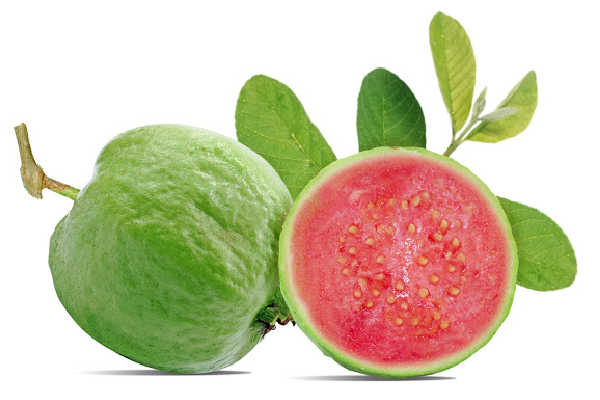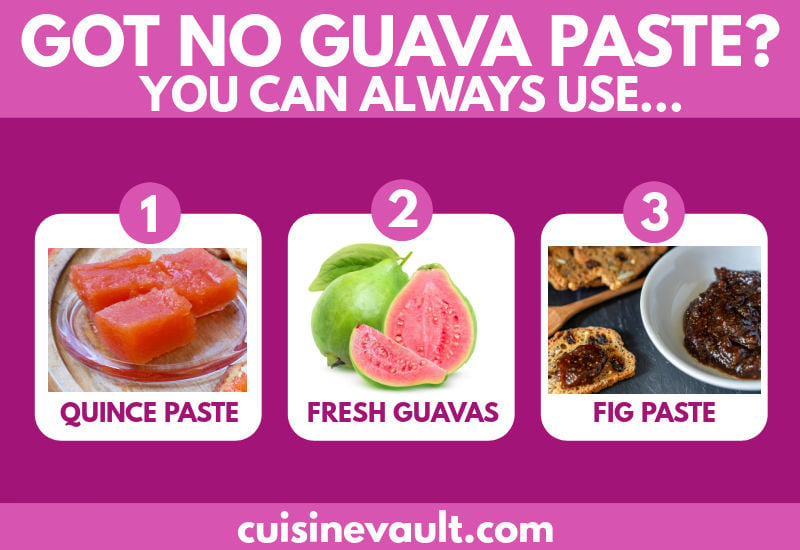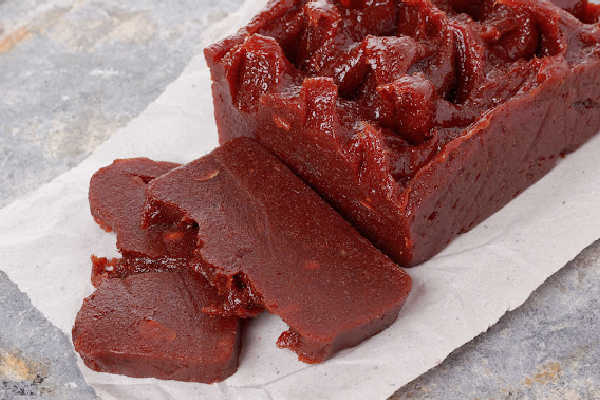Guava paste is a sweet type of conserve that has a smooth texture with a tropical, floral aroma. Its consistency is similar to quince paste and can be smeared onto toast, stuffed into pastries, or served as a block with its best friend, cheese.
If you can't get your hands on any guava paste, then you're going to need an alternative. We've compiled a list of our favorite guava paste substitutes so that you can finish any recipe without the original ingredient.
What can I use to replace guava paste?
If you need a substitute for guava paste then your best options are quince paste, fresh guavas, fig paste, fruit preserves, or apple paste. While they don't perfectly mimic the flavor and texture, they also won't be out of place in any dish that calls for guava paste. If you've got a bag of fresh guavas you may also want to make a batch at home. We've provided a recipe further down the page which is quick and easy to follow.
1. Quince paste
Quince paste, also known as membrillo, is a useful guava paste replacement. It shares a similar sweet taste and thick, sliceable texture. It can be used in practically any food that calls for guava paste and is easy to find in most grocery stores.
If you're creating a Latin American or Caribbean dish that's calling for guava paste then this alternative will work just as well. Can’t find it at your local supermarket? Try European specialty stores, or simply buy some online.
2. Fresh guavas
If you’re able to buy fresh guavas where you live, then you can use them as a replacement in some applications. The fresh fruit, cut into pieces, works just as well on a cheeseboard. For baked goods like pies, fresh guava will also be suitable. Just remember to increase the sugar because the paste is much sweeter than fresh guavas.

Guava paste has been cooked for hours with sugar, and sometimes additional ingredients like lemon juice, pectin, or spices. Using fresh guavas will result in a fruitier, cleaner taste.
3. Fig paste
Fig paste closely mimics guava paste and makes a great substitute. The biggest difference is the tiny seeds that get left in fig paste - these will affect the texture, resulting in a grainier mouthfeel.
Note: In most applications, fig jam is not a suitable alternative as it is much thinner and runny. In a pinch, you could use it as part of a sauce.
4. Fruit preserve
Depending on the recipe, try using a fruit preserve such as strawberry, pineapple, or apricot. Although their textures will vary depending on what brand you buy, preserves will have a softer consistency.
When adding to toast or filling pastries this option will work fine. However, for cheese boards or situations where you need a firm, solid texture, a preserve will be out of place.
Related reading: check out our apricot jam recipe which is simple to make and tastes so good.
5. Apple paste
Apple paste has a texture that is a lot like quince paste. Commercial brands are usually made from apple and citric acid. Although its main use is for cheese boards, apple paste brings sweetness to stuffing and can be used as a sauce for pork, chicken, duck, pheasant, or other gamey meats. Pair this paste with Gruyere, Comté, Roquefort, or Gorgonzola for the perfect flavor combination.
Apple paste may not be easy to find in some grocery stores, but a quick online search will provide plenty of options. Look for a product that doesn't have awkward spices and flavors added. Sometimes less is more.
6. Make your own
Is it guava season in your part of the world? If you've got a bag and don't know what to do with them, then follow this simple recipe to create your own guava paste at home.
Makes: 2 pounds
Ingredients
- 2 lbs (900g) guavas, peeled and halved
- 1 cup + ½ cup water, divided
- 2 lb granulated sugar
Method
- Scoop the seeds from the halved guavas and add them to a small bowl with a cup of water. Leave to soak.
- Transfer the guava flesh to a saucepan with the remaining half cup of water. Heat on high until boiling then reduce and simmer the fruit, stirring often, until it turns soft.
- Pour seeds through a strainer and add the water to the guavas. The seeds can be discarded.
- Use a food mill to process the guavas into a pulp then transfer to a large heavy saucepan. Pour in the sugar and cook on a low heat, using a wooden spoon to stir constantly until the mixture thickens. It's ready when a small scoop of jelly can be placed on an ice tube briefly and then lifted off in one piece.
- Remove saucepan from the heat and stir with a wooden spoon until the mixture transforms into a thick, heavy paste. This should take roughly 10 minutes.
- Scoop the paste into a suitably sized pan (such as a loaf pan) that is lined with wax paper and allow to sit overnight in a cool spot.
- Carefully transfer the paste into an airtight container or wrap it in foil, ensuring there are no gaps.
Tip: to produce a firmer, drier guava paste allow it to sit on wax paper, covered with cheesecloth, in the sun for two days. Remember to occasionally flip the paste over.
Commonly asked questions
Does guava paste melt?
Guava paste is suitable for melting and it will take 10 to 15 minutes to complete. Slice the paste into 1” pieces using a sharp knife and then add to a small saucepan with a splash of water. Cook on low-medium heat, using a spatula or spoon to help breakdown the paste, until it reaches the consistency of thick jam.
How do I store guava paste?
Once a pack of guava paste is opened, wrap securely in plastic or place in an airtight container, then store at room temperature in a cool dry place. If you don't use a lot of guava paste you may want to store it in the refrigerator for up to 12 months.
Where can I buy guava paste?
Visit the Latin section of your local supermarket or try a specialty store to find guava paste. It is often labeled as pasta de guayaba. Another good option is to search online as several brands are selling this ingredient in the United States.
Related reading:
What do feijoas taste like?
What are some useful substitutes for figs?
Fast facts about guava paste
- Avoid using guava paste to replace guava puree or juice as it has much higher sugar content and its texture is a lot different.
- Guava paste is known as goiabada in Portuguese.
- It is a popular ingredient in the Caribbean, served as an appetizer with cheese or added to desserts. In Cuba and Puerto Rico, the paste is used to make pastelitos, a type of puff pastry dessert.
- They have a naturally high pectin content which helps turn the paste into a thick consistency when heated.
- Guavas are a tropical fruit with thin skins and are native to South America. The fruits contain high levels of vitamin A and C.
Summing up
If you don’t have any guava paste in the kitchen then we recommend using quince paste, fresh guavas, fig paste, fruit preserves, or apple paste. Although not perfect matches, they won’t be out of place in many recipes. Use your judgment though, as fresh guavas and fruit preserves have a completely different texture and may not be appropriate for some dishes.
It's also worth pointing out that guava jelly does not make a good substitute for guava paste. Its texture is less dense and has different uses in the kitchen.
What are you going to use guava paste for? Please let us know in the comments below.



Sandy CLEVELAND
I do get tickled at writers, obviously from large cities, who suggest using products that are just as hard to find, if not harder, than what they are substituting. Yep, I’ll just run outside and grab some fresh guavas in our below freezing weather. Most of these products I’ve never seen or heard of. Our closest grocery is 45 min. away, so I’m looking for substitutes I can store. We have found some Mango paste by Goya (haven’t found their other flavors around here) at a store only about an hour away, but we can stock up and it lasts a long time on the shelf wrapped tightly. I like to use it to make a glaze or sauce for wings or chicken of any kind, salmon, pork, whatever. I just melt some on the stove with enough water to keep it from burning, mashing it against the sides of the pans to help it along. I add a little salt and pepper, ground green chilies and granulated jalapeño or fresh if I have it. I add garlic, fresh or granulated, a splash of lemon juice or even lemon pepper to brighten it and finish it off with enough butter to make it good! I want to try the paste in some dessert form, so I saw the recipe on the Goya site with slices of the paste and cream cheese between sheets of puff pastry. It’s next on my need-to-make list.
P.S. Please remember that not everyone has a grocery or market within a mile or two. Many of us live in the country and sometimes, especially during the pandemic, we have to make do without all fresh foods. We’re learning which products are best and last the longest.
Hope this helps you figure out other uses and opens your horizons on food prep.
Nate Teague
Hi Sandy, thanks so much for your comments, and I'm sorry our list couldn't help. We always try to think of people with limited options and, in this article, included fruit conserve as the easier choice. Your mango sauce sounds mouth-wateringly good! It sounds like a great substitute so I'm glad you mentioned it for other readers.
PS. Sounds like you should be writing for us 🙂